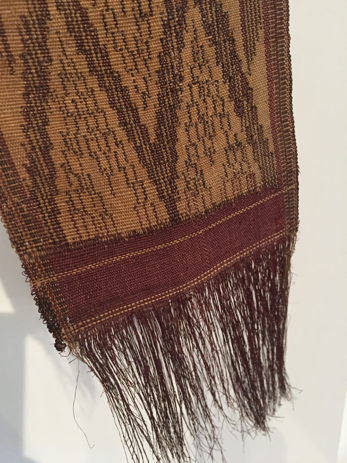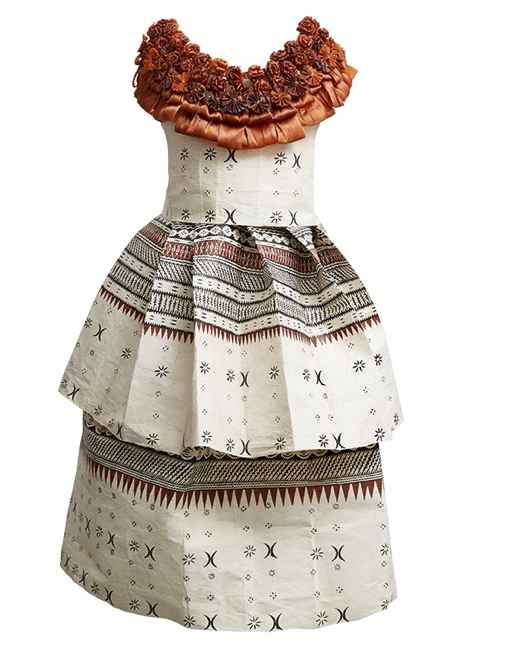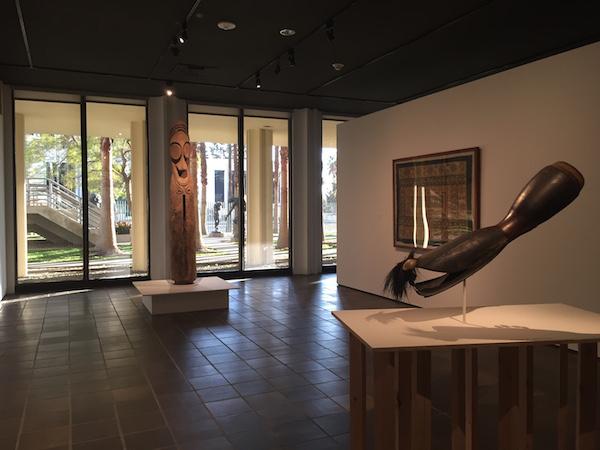LACMA’s Art of the Pacific gallery has just been installed with a remarkable group of textiles and accompanying objects from the Pacific islands. Pacific Islanders across a wide swath of the Pacific create textiles known as tapa, or kapa in the Hawaiian Islands. This cloth is generally made from the bark of the paper mulberry tree, while fibers from other plants, such as breadfruit, banyan, wild fig, hibiscus, or banana are less commonly used. The inner bark of the mulberry is collected, soaked, and beaten with a wooden tool against a hard surface, separating the fibers. The cloth is pounded with successively smaller grooved mallets, extending the size of the sheet and often layering or felting together the sheets to make larger pieces. The range of painted designs is characteristic of various Pacific regions and may be stenciled, stamped, hand-painted, or dyed.

Most of the examples in this installation were made using these techniques; however, an exquisitely crafted Man’s Sash (Tor) from a more western area of the Pacific, the Caroline Islands of Micronesia, was tightly woven on a loom using banana and hibiscus fiber. The tough strings were left their natural tan color or tinted red with vegetable or mineral dyes.
Significant historic works such as an 18th-century Hawaiian tapa (textile on the right, above) collected in 1778 by John Webber, the artist accompanying Captain James Cook on his third and final voyage, are paired in the gallery with other important objects. Above, a drum (pahu) acquired on the same voyage is exhibited nearby.
Across the Pacific, tapa garments and household elements (room dividers, bedcovers) served as objects of prestige, exchange, and artistic virtuosity. Large rolls of tapa were made for gift presentations or dressing individuals at significant ceremonies such as investitures or weddings.
New additions to LACMA’s permanent collection were carefully treated prior to the installation by members of the LACMA Conservation Center. Treatments ranged from the careful combing of long fringes to the application of small Japanese paper patches with wheat paste to reinforce weak areas of heavier or long tapa.
Several of the longer panels were installed in the gallery using paper-wrapped magnets supporting the tapa and with substantial team effort.
The techniques of tapa production are thought to have originated in southern China and mainland Southeast Asia more than five thousand years ago. From there, they were introduced to the Pacific from eastern Indonesia, where the techniques were further developed and refined. The early ancestors of the Polynesians transferred these traditions from the islands of Melanesia out into the wider areas of the Pacific.
The making, wearing, and gifting of tapa continues to be of great social importance to Pacific Islanders; tapa is used in weddings, funerals, clothing, dance, and as ornament. The rich tapa-producing regions of Hawaii, the Society Islands, Cook Islands, Niue, Futuna (Vanauatu), Caroline Islands, and Fiji are represented here, along with other selected objects from LACMA’s growing Art of the Pacific collection. Additional works have been provided on loan from the collection of Mark and Carolyn Blackburn, Honolulu.

LACMA will be hosting a major exhibition, Fiji: Art and Life in the Pacific, in Fall 2019, which will feature important and early examples of traditional Fijian tapa. Also included in the exhibition will be examples of contemporary tapa garments, such as this Wedding Dress (2012), which is part of the collection of the Sainsbury Research Institute, Norwich, England.
Visit the Art of the Pacific gallery in the Ahmanson Building, Level 1.



